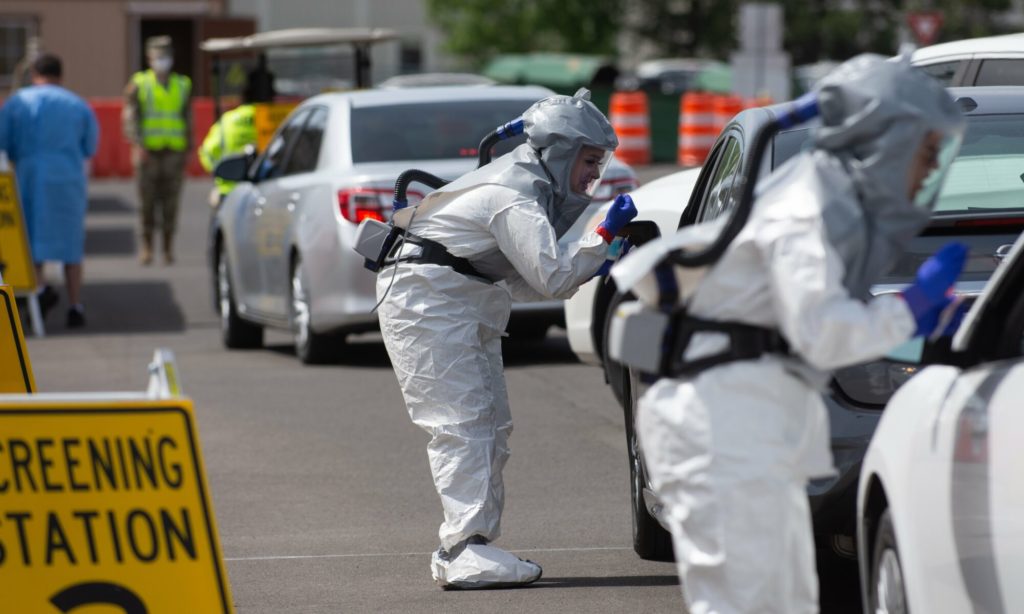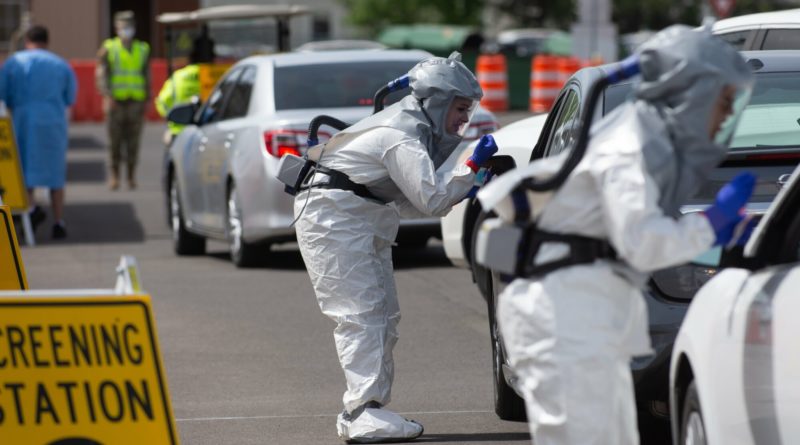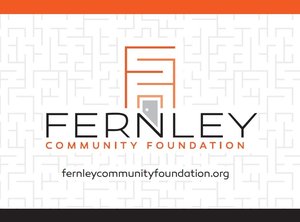State officials detail increased demand for public assistance, response to nursing home outbreaks at legislative health meeting

By Megan Messerly
https://thenevadaindependent.com
State officials projected Wednesday that nearly a quarter of the state’s population will be enrolled in Medicaid, the public health insurance program, by the end of May as the state weathers an unprecedented economic crisis amid the ongoing coronavirus pandemic.
Those projections came at a Wednesday meeting of the interim Legislative Health Committee, where lawmakers received updates from state officials on the apparently improving coronavirus situation in Nevada, the increased demand for public assistance and an expansion of the state’s volunteer behavioral health workforce, among other topics.
A cadre of state health officials, including top administrators within the state’s Department of Health and Human Services, detailed for lawmakers how the department is responding to the novel coronavirus at the group’s first meeting since the pandemic began. That response includes everything from keeping an eye on the state’s nursing homes, which have emerged as a hotspot for COVID-19 outbreaks, to taking advantage of flexibility from the federal government to expand public assistance programs.
State health officials were also forward looking in their assessments, including detailing for lawmakers what legislative changes might be needed down the road. Richard Whitley, director of the Department of Health and Human Services, listed improving the state’s ability to track deaths in real time and boosting Nevada’s lab testing capacity as two of his top priorities.
“I think to be better prepared to have some of these things in place so that we could activate them and not sort of stand them up while we’re trying to deal with a crisis would be helpful,” Whitley said.
But the biggest overall need, Whitley said, is for public health funding.
“We don’t invest much general fund into public health, and it’s not identified until it’s needed,” Whitley said. “I mean it’s clean air, clean water, safe food, and until it goes wrong, it’s not really valued by many people.”
Below, The Nevada Independent explores some of what was discussed at the meeting.
Increases in Medicaid, SNAP and TANF caseloads
Unemployment rates have skyrocketed in Nevada and across the nation as states required nonessential businesses to close their doors to reduce the spread of the novel coronavirus. It is unsurprising, then, that the demand for public assistance in Nevada is up as well, though the increases they have seen have not been as extreme.
Data presented to lawmakers on Wednesday show that about 760,000 people will be enrolled in the state’s Medicaid program by the end of May, or about 22 percent of the state’s population. As of April, there were about 670,000 people enrolled in the public health insurance program statewide, about 3.4 percent more than the previously projected caseload and up about 3.7 percent from March’s totals.
However, state health officials noted that while Medicaid enrollees are up, utilization of non-COVID medical care may be down. Suzanne Bierman, the administrator of Nevada’s Medicaid program, said that preliminary data show “deep reductions” in dental services, primary care and pediatric vaccination rates, though there is a lag in reporting medical claims that makes it difficult to make any definitive conclusions yet.
“We are definitely seeing those sorts of decreases in utilization, it’s just given claims lag and a number of other factors, we don’t really have complete or reliable data yet,” Bierman said.
Medicaid covers all medically-necessary services related to COVID-19, including testing, treatment and hospital care.
Medicaid has also made or plans to make a number of changes to its program in the time of the pandemic. For instance, the state Medicaid program is asking the federal government to reimburse 100 percent of COVID-19 testing for a new uninsured eligibility group. It is also asking for COVID-19 testing and treatment to be covered for undocumented individuals and other non-citizens.
Bierman framed the changes as “one critical part of doing what we can to secure the flexibilities needed from the federal government to make sure that we are keeping access to services available and doing everything that we can to support providers in terms of leveraging additional flexibilities through the program during this time.”
At the same time, caseload for the Supplemental Nutrition Assistance Program, or SNAP, was up by about 2.7 percent of projected levels, at about 430,000 SNAP recipients as of March, or about 14 percent of the state’s population. The state’s analysis shows that actual SNAP enrollments are following the state’s worst case projection, which anticipates about 490,000 people enrolled in the program by the end of May.
Steve Fisher, administrator of the Division of Welfare and Supportive Services, told lawmakers that the state has issued $56 million in emergency allotments to about 140,000 SNAP households in March and April. He said that the additional funding has gone toward providing additional benefits to households that had not yet reached their max allotment.
Fisher also noted that beginning around the first week of June, SNAP recipients in Nevada will be able to use their benefits to purchase food online through Walmart and Amazon and have it delivered at no charge.
A third change is allowing the state to provide temporary emergency SNAP to children who lost access to free or reduced price lunches at school; families can receive $5.70 a day for each school day their child misses, expected to total about $228 per child. More than 324,000 children across Nevada are expected to qualify for the benefit, costing about $74 million.
Other adjustments being made to the SNAP program include suspending work requirements for able-bodied adults without dependents and allowing SNAP recipients to substitute different kinds of milk if the eligible products are not available for purchase.
A third public assistance program, Temporary Assistance for Needy Families, or TANF, is about 7.3 percent above the legislatively approved caseload for April at about 22,000 recipients enrolled, or less than 1 percent of the state’s population. However, it does represent a 10.3 percent increase in enrollees since March. The state projects that 24,000 people will be enrolled in the program by the end of May.
For comparison, 462,396 people filed a new unemployment claim this year, which represents about 30 percent of the state’s workforce, and Nevada’s insured unemployment rate — the rate of people who are eligible for unemployment benefits who are unemployed — stands at 23.5 percent, up from 1.4 percent pre-pandemic.
Fisher said that there is now continuous eligibility for all three assistance programs, meaning that anyone who was eligible for any of the programs in March cannot be terminated unless they left the state voluntarily or voluntarily removed themselves from the program.
COVID-19 updates
Kyra Morgan, the state’s biostatistician, told lawmakers some good news on Wednesday morning: The state’s overall test positivity rate — that is, the number of total positives as a percentage of total people tested — has continued to decrease as testing ramps up, down to 7.9 percent as of Wednesday morning. Morgan said that if that number continues to decrease, the state will be “pretty comfortable” that it is testing everyone who needs to be tested.
“If you have a really high percentage of folks coming back positive, you know that that’s an artifact that you don’t have sufficient testing. It’s very likely that if you have a high percentage of tests coming back positive, that means that you’re still restricted in access to tests to those who are not even just symptomatic but fairly severely symptomatic,” Morgan said.
However, at this point, the state isn’t sure how many people who are testing positive are asymptomatic. Morgan said that disease investigators in Southern Nevada have faced such a high volume of positive cases that they have not been able to contact every positive patient individually to track their symptoms and the onset date of their symptoms.
“We don’t have that information on every single case,” Morgan said.
There is another piece of good news, though. Though Nevada saw big spikes in the growth of COVID-19 cases and deaths at the beginning of the pandemic, the growth rate has leveled off. Morgan said that the number of new cases has grown by about 1.6 percent daily over the last week, while the number of deaths has grown about 1.1 percent daily.
“This means that social distancing and restrictions have worked. Models indicate a very high likelihood that Nevada reached our peak in the number of new cases being recorded daily, and we’ve actually been declining in new cases since the end of April,” Morgan said.
However, she noted that models assume continuation of current control measures and that as the state starts lifting the restrictions it has put in place, it expects to see more cases.
“We realized in DHHS that outbreaks will continue to happen, but the goal is to be able to contain those outbreaks,” Morgan said. “At this point, Nevada has built the infrastructure required for our health care and our public health systems to be able to adequately respond.”
Morgan also told lawmakers that while some people have assumed that COVID-19 deaths are being overreported, she said the opposite is the case in Nevada, which only counts COVID-19 deaths that have been laboratory confirmed. That means the total could be missing people who died at home because of complications associated with the virus without ever getting tested, or other individuals who for whatever reason were not tested.
“Everyone here that’s attributed here to COVID-19 as having a death is in fact a confirmed laboratory positive COVID case,” Morgan said. “Most of these are also dying during their hospitalization, which is directly related to COVID as well.”
Whitley also told lawmakers on Wednesday that the state has not yet had a reported case of a new multisystem inflammatory syndrome affecting children with COVID-19, though it has taken the steps necessary to track it. Assemblywoman Robin Titus, a doctor by trade, told committee members that she had received guidance from the state on what to look for to spot the new syndrome.
“The goal here is just education and keeping us aware and keeping our feelers out, our antennas up and making sure that we don’t get complacent about this that, yes, kids can get this and, and we may see an emerging process of this disease,” Titus said.
Nursing home issues identified
So far, three outbreaks of COVID-19 in congregant living facilities have been in Northern Nevada — Willow Springs, a residential treatment facility in Reno; Lakeside Health and Wellness, a nursing home in Reno; and Arbors Memory Care, an assisted living facility focused on memory care in Sparks. A fourth, at the Heights of Summerlin nursing home, was reported by the Las Vegas Review-Journal on Wednesday afternoon.
Whitley, speaking to lawmakers earlier in the day on Wednesday, said the outbreaks have been largely attributed to three specific violations of best practices for infection control, including improperly worn personal protective equipment, the lack of isolation of patients who were infected and improper hand washing. He said that the state has a team of health inspectors and epidemiologists that go into each facility as soon as a case is identified to make sure they are following best practices to limit the spread of the virus.
“Those are all sort of improvable behaviors that could occur in the facility,” Whitley said. “So actions were taken, the issues identified, corrective action put in place.”
In the case of Arbors Memory Care, Whitley said that an infected patient, who was known to wander, wandered through the facility. The state has also identified a list of high-risk facilities that have had known infection control violations in the past to inform its regulation, Whitley said.
The good news, Whitley said, is that deaths in Nevada nursing homes only account for about 20 percent of the state’s COVID-19 deaths, where they have accounted for more than 50 percent in other states. Nationally, one-third of COVID deaths have been linked to nursing homes.
“There have been these three big outbreaks in Northern Nevada, but overall the state is doing well,” Richard said. “I think we’re being responsive, we get a team in there, we make the corrections. That’s not always as transparent.”
The hard part has been communicating with the loved ones of those inside who are no longer allowed to visit because of the potential to unknowingly introduce the virus to the facility. Whitley said that the state has encouraged and made available videoconferencing to facilities, but acknowledged that can’t replace face-to-face visits.
“Nothing replaces being able to be present with a loved one in a facility, and this is where our regulatory role to protect the patient and the spread of the disease does override that accessibility piece of people entering into the facility,” Whitley said.
Other services provided by the state
Like Medicaid and the Division of Welfare and Supportive Services, the Aging and Disability Services Division has also asked the federal government for additional flexibility in the time of the pandemic.
For instance, services that were once required to be provided in a congregant setting, such as jobs and day training, can now be provided at home, guardians and spouses, who serve as someone’s legally responsible individual, may now provide in-home services, and support services, such as helping someone with personal hygiene tasks, can be conducted via a phone call or FaceTime prompt.
At the same time, the aging side of the Aging and Disability Services Division has partnered with community-based services, clinical providers and the Nevada System of Higher Education to form the Nevada COVID-19 Aging Network, or Nevada CAN. The network is focused on using its team of more than 120 student and community volunteers to connect with elderly individuals to check in on their needs and connect them with services, including telemedicine and food delivery, as needed.
“This group is a collaboration of folks trying to make sure that seniors have the ability to continue to stay connected to one another, continue to stay connected to their family members, their community, and those types of activities,” said Dena Schmidt, the division’s administrator. “Our goal was to be able to make sure that seniors and vulnerable populations have the ability to stay home and stay safe.”
Schmidt shared the story of a 76-year-old man and his wife who live in Southern Nevada but have no family in town. The police had been conducting regular wellness checks on the couple, but those stopped once the pandemic hit.
“When he called our agency and spoke to the social services support group, he basically indicated that without somebody calling, nobody would know if he was alive, which was heartbreaking for us,” Schmidt said. “And so we connected him to our one-on-one checks, and they are enjoying those conversations with a volunteer and making sure that they’re staying connected.”
Volunteers are stepping up on the behavioral health side of the equation too. Stephanie Woodard, the state’s senior advisor on behavioral health, told lawmakers that the state has set up a mental health counselor volunteer pool, which has signed up 53 individuals with another 40 being researched, and a psychological first aid volunteer pool, with 63 people who have been accepted and another 66 being researched, as part of the state’s SERV-NV, or State Emergency Registry of Volunteers-Nevada, program.
“We really do try to stand at the ready so that if there is a need by local jurisdiction for specific resources, in this case, psychological first aid counselors, as well as mental health counselors, that they can submit a request for those resources and then we can push out that request to all of the individuals that are in SERV-NV, and they can then volunteer specifically to answer that request,” Woodard said.
Woodard said that the state held a psychological first aid training in early April that saw 500 registrants and 320 people actually finish the two-day course.
It’s part of the state’s efforts to prepare for a surge in demand for behavioral health services, Woodard said. Other steps the state is taking include securing grant funding from the federal government to expand access to mobile crisis services for children, boost crisis counseling services and support suicide prevention efforts.
“All of us have been impacted by isolation and stay at home orders, as well as just the changes to our day to day life,” Woodard said. “When we try to establish what is the population of focus when responding to a disaster. We need to look very globally, when we’re talking about a pandemic, knowing that every citizen has been impacted in one way or another.”




